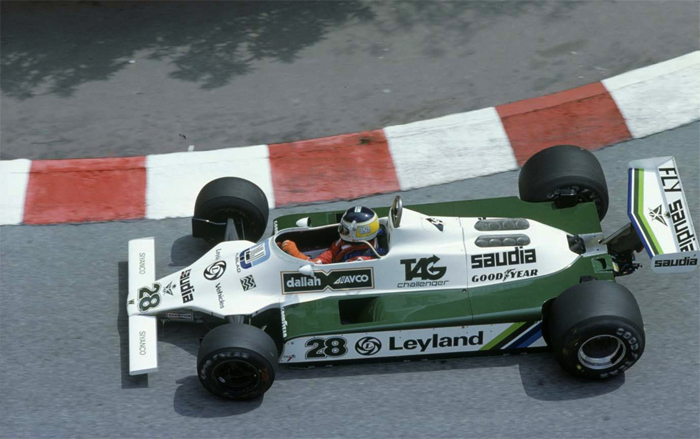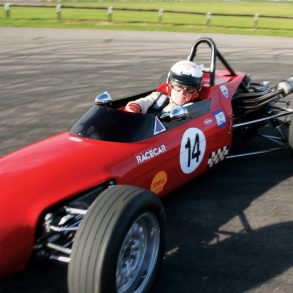Williams-Ford FW07B
Car: Williams-Ford FW07B / Engine: Cosworth DFV 90º V8 / Maker: Williams / Bore X Stroke: 85.7 mm X 64.8 mm / Year: 1980 / Capacity: 2,993 cc / Class: Formula 1 / Power: 485 bhp / 362 KW @ 10,600 rpm / Wheelbase: 2,692 mm / Track: Front: 1738 mm Rear: 1600 mm / Weight: 168 kilo / 370.4 lbs
Money from the Middle East with sponsors like Saudi Air and interestingly the Saudi Binladen Group plus the hiring of promising young engineer Patrick Head would turn the Williams team into a front runner.
Head designed a car that would exploit the promise of ground-effects by developing the concept beyond anything done by it’s originator, Lotus. It’s important to understand that when the Lotus 79 first appeared on the track then other team knew that car design would never be the same again. Ross Brawn remembers that Williams actually built a wind-tunnel model of what they thought was a faithful representation of a Lotus 79:
the first time we ran it in the tunnel, we thought the dials had gone wrong. We were shocked, and just sat there in amazement at what our first crude attempt had produced — four or five times better than the flat-bottomed car we were racing at that time. We just didn’t appreciate the extent of its potential until we got a scale model into the tunnel. It was an eye-opening experience.
Frank Dernie, Head’s first aerodynamic assistant, working in the Imperial College wind tunnel in London, helped Head and assistant designer Neil Oatley to produce the Williams FW07. The car’s principle strengths would come from a better understanding of the hugh increase in aerodynamic loads that ground effects would bring. The cars monocoque chassis was constructed from an aluminum honeycomb, making it considerably stiffer than that of its FW06 predecessor. The suspension was conventional double wishbones, but with very stiff springs. The package was rounded off by the Cosworth DFV engine and would prove stronger than the sum of its parts.
Even though the car arrived too late to be a force in the championship, and minor problems and accidents hampered the FW07s early in its career, it was immediately obvious that Williams had produced a winner. This promise was fulfilled when at the British Grand Prix Australian Alan Jones qualified on pole and led the early part of the race with Swiss driver Clay Regazzoni in second. When an overheated engine did Jones in Regazzoni was able to hold on for the win. It was Williams’ first victory that was soon by a Williams 1-2 at Germany with Jones leading Regazzoni to the flag. Jones would go onto win the Austrian, Dutch and Canadian Grands Prix before the season was done. Though he won the most races in the season he would only finish third in the championship to the Ferraris of Jody Scheckter and Gilles Villeneuve. To all their competitors on the grid it seemed apparent that Head and Williams had moved a step ahead of everybody else in the ground effects territory. Williams was the team to beat in the second half of the season and finished second in the constructor’s championship. It was quite remarkable to note that a Williams had never lead a lap before the 1979 season in which they scored five victories.
Head did not sit still and further developed the underbody and monocoque of the FW07 and Williams started the 1980 season with the FW07B as clear favorites. Regazzoni was replaced by Argentinean Carlos Reutemann and at the opening race in Argentina, jones took the flag over Brazilian Nelson Piquet. The third race of the season in South Africa saw FISA-FOCA war brought into the spotlight. FISA, the governing body of international motorsports (and the organization that the 3 big constructors (Renault, Ferrari and Alfa Romeo were aligned to) led by Jean-Marie Balestre, complained with a straight face that the ground effect cars of the time were too fast through the corners, and FOCA (Formula One Constructor’s Association, representing the mostly British independent constructors) led by Bernie Ecclestone and Max Mosley, argued that the superior road-holding of the independent teams’ cars served as an equalizer to the power advantages that the manufacturers had, particularly the Renault turbos.
The next win for the Williams would not come to round six at Monaco where Reutemann took the victory. Alan Jones won at the Spanish Grand Prix but the race was stripped of Championship status when the FISA-supported manufacturer teams- Renault, Ferrari, and Alfa all pulled out. The French Grand Prix was run under a specter of recrimination which Jones chose to ignore taking the win. Jones repeated the win at the British Grand Prix. Two more wins in Canada and the United State clinched the World Championship for Jones and Williams. The championship winning FW07B was carried over for the 1981 season and the successful driver pairing was also left unchanged. Reutemann continued the good form with a win in the opening round of the season at Kyalami in South Africa. Changes were required after that race as the sport’s governing body decided to ban moveable skirts in an attempt to slow the cars down through the corners. The immediate answer was the Williams FW07C, but the team wasted precious time that season to create an active suspension system that would make sure the fixed skirts were attached to the road at all time. Eventually the team got the car sorted and Williams ended the season with four wins and another constructor’s cup. Jones won the last race of the season, which would also be his last Formula 1 race as the 1980 World Champion hung up his helmet at the end of the year.
As had become tradition, the new 1982 Williams did not debut until a few races into the season. Before the FW08 was debuted, two second place finishes were scored with the FW07C. The new car followed the FW07’s design, but was more compact and aerodynamically efficient as it was designed specifically for the fixed skirt regulations. Jones’ replacement Keke Rosberg scored just one victory, but it proved enough to claim the driver’s championship. Williams finished only fourth in the constructor’s standings. The reason why the FW08 was so compact became apparent at the end of the season as Williams was caught testing a six-wheeled variant with four rear wheels. It was never raced as the FIA banned six-wheelers starting in 1983.
















